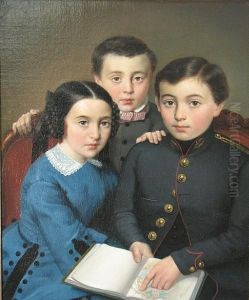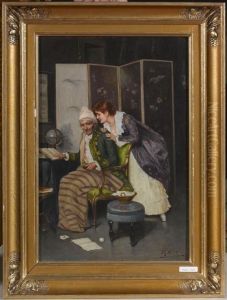Albert Bettannier Paintings
Jean Baptiste Édouard Albert Bettannier was a French painter born on December 25, 1851, in Metz, which at the time was a part of France. He is best known for his works that evoke patriotic themes, produced in a historical context where France was coping with the aftermath of the Franco-Prussian War and the loss of Alsace-Lorraine to the newly formed German Empire.
Bettannier studied art at the École des Beaux-Arts in Paris, where he was influenced by academic painting traditions. His early works were typical of the genre scenes and historical paintings favored by the Academy at the time. However, the loss of Alsace-Lorraine, a region that had a profound impact on French national sentiment, became a recurring theme in his art.
One of Bettannier's most famous paintings, 'La Tache Noire' (The Black Spot), created in 1887, depicts a schoolroom with a map of France that has a black spot where Alsace-Lorraine should be. This painting reflects the poignant sense of loss felt by many French citizens and is an example of how art was used to comment on political issues.
Throughout his career, Bettannier exhibited at the Salon de Paris, which was the official art exhibition of the Académie des Beaux-Arts. His works resonated with the French public, who were dealing with the nationalistic strife and humiliation that followed the defeat in the Franco-Prussian War. Bettannier's paintings often portrayed Alsace-Lorraine as an integral part of France and expressed a longing for the return of these territories.
Albert Bettannier continued to paint until his later years, and his works remain a testament to the power of art in expressing political sentiment and national identity. He passed away on October 14, 1932, in Saint-Maur-des-Fossés, France. His art lives on, housed in various collections and museums, serving as a historical record of the sentiments of his time.

